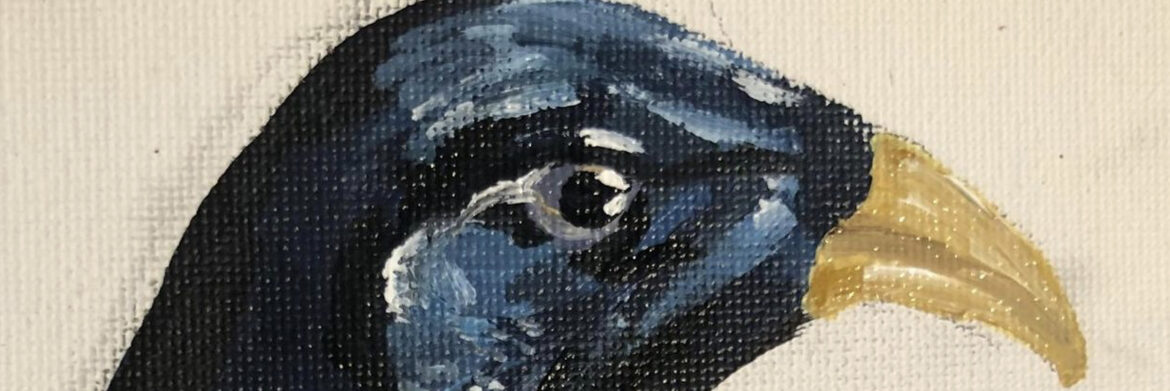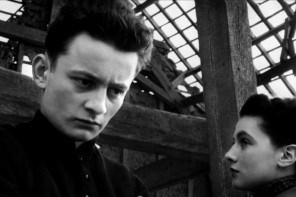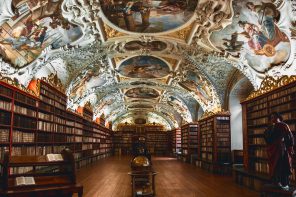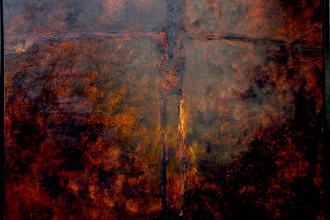The Color of Distance
The idea of distance starts with the sea. The sea finds its way to me through things splashed with blue, and the blue I know is a blue that moves:
A blue and white patterned plate of bent blossom branches hangs on a wall wherever home is.
A set of navy suitcases with frayed edges. They have been lost to places I will never go.
A flickering map on an airplane screen seems static until it meets the smudge of my thumb and index finger. I can expand and contract the darkness between departures and arrivals for hours.
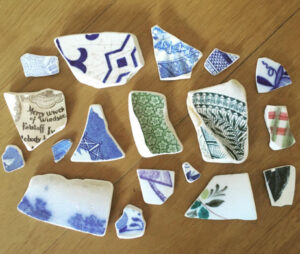 I have spent most of my life on islands and coastlines, from my first home, Maine, to Japan, Australia, Ireland and Scotland. In Maine, the sea is studded with diamonds of salt. It is ‘heaven blue in an opposite way’, in contrast to the state’s dense forests, and ‘straight and unsolvable’, as I wrote in 2017 in some of the final lines of my poem ‘Afresh’.1 My family decorates our home with past lives on Japanese blue and white dishes and indigo-dyed cloth.2 These bodies of water and bodies of blue are reminders of the places we have left, and the parts we left with.
I have spent most of my life on islands and coastlines, from my first home, Maine, to Japan, Australia, Ireland and Scotland. In Maine, the sea is studded with diamonds of salt. It is ‘heaven blue in an opposite way’, in contrast to the state’s dense forests, and ‘straight and unsolvable’, as I wrote in 2017 in some of the final lines of my poem ‘Afresh’.1 My family decorates our home with past lives on Japanese blue and white dishes and indigo-dyed cloth.2 These bodies of water and bodies of blue are reminders of the places we have left, and the parts we left with.
For the last five years, I have embraced (braced myself against) the chill winds of the Scottish North Sea, walking its beaches, combing the sand for shards of pottery and frosted sea glass, and occasionally, taking a few deep breaths in before I slip underwater and everything is transfigured. In the sea’s vastness, I feel closer to and further from something I can’t name. I keep returning to the shore until I find a blank white shard of ceramic that reveals an underbelly of blue willow, or I hear a seal bark.
***
For centuries, artists, poets, and philosophers have meditated on the colour blue. Historian Michel Pastoureau’s Blue: The History of a Colour offers a meticulous and thoughtful account of the story of blue in Western art and culture. The cultural history of blue is complex and particular to different cultures and places, and this reflection only contains a few interpretations of the color in contemporary literary, theological, and personal contexts.
In 1810, Goethe published his Theory of Colours (Zur Farbenlehre) in which he described blue as a ‘stimulating negation’ and ‘contradiction between excitement and repose’, suggesting that ‘we long to contemplate blue, not because it advances to us, but because it draws us after it’.3 Blue signifies an encounter with beauty that recedes and departs from us, and the longings we maintain.
In Bluets (2009), a book of prose-poetry that invokes pre-Socratic philosophical fragments, writer Maggie Nelson includes Goethe’s study of blue as a motif of longing as she grieves the breakdown of a relationship and witnesses the suffering of a close friend. In the subsequent 240 propositions, Nelson wades through complex emotions, images and encounters ‘under the spell of blue’. Nelson curates blue objects, and images, and places them in fragments, imagining each object as a ‘kind of burning bush’, asking ‘how could all the shreds of blue garbage bags stuck in brambles, or the bright blue tarps flapping over every shanty and fish stand in the world, be, in essence, the fingerprints of God?’4 Nelson’s frequent questions and moments of revelation are then negated, replaced by more questions, and more blue.
In A Field Guide to Getting Lost (2010), writer Rebecca Solnit explores the power of dwelling in the unknown and meditates on the color blue as the ‘edges and depths’ of the world:
For many years, I have been moved by the blue at the far edge of what can be seen, that color of horizons, of remote mountain ranges, of anything far away. The color of that distance is the color of an emotion, the color of solitude and of desire, the color of there seen from here, the color of where you are not. And the color of where you can never go. For the blue is not in the place those miles away at the horizon, but in the atmospheric distance between you and the mountains…blue is the color of longing for the distances you never arrive in, for the blue world.5
Like Nelson, Solnit integrates the scientific and poetic. For Solnit, the color blue mediates this experience of absence, explaining, ‘Blue is the light that got lost. Light at the blue end of the spectrum does not travel the whole distance from the sun to us. It disperses among the molecules of the air, it scatters in water…this light that does not touch us, does not travel the whole distance, the light that gets lost, gives us the beauty of the world, so much of which is in the color blue.’6 Solnit suggests that the tenuous relationship between desire and distance is the ‘root of our deep-seated unease with desire’.7 Nelson and Solnit’s meditations on blue are tinged with mystery and rich with theological meaning: ‘The far seeps in even to the nearest. After all, we hardly know our own depths.’8
Ecstatic Accidents
From the late Medieval period in Europe, blue has been associated with divine light and the heavenly realms. The Virgin Mary is often cloaked in shades of blue, and iconographic depictions of the Transfiguration frequently feature a blue mandorla.9 Nelson turns to these mosaics and paintings of the Transfiguration, in which the ‘dazzling darkness’ appears with ‘startling regularity’ as blue.10 As Nelson explains, ‘the blue of the sky depends on the darkness of empty space behind it.’ As one optics journal puts it, ‘The color of any planetary atmosphere viewed against the blank of space and illuminated by a sunlike star will also be blue.’ In which case blue is something of an ecstatic accident produced by void and fire.’11 The contrast of void and fire, of absence and presence, resonates with Nelson’s earlier comparison of blue objects to the sacred burning bush, a signifier of divine presence in the natural world.
The Aberdeenshire poet and writer Nan Shepherd (1893–1981) also writes of this paradox, in the ‘burning blue’ of the Scottish mountains when the borders of her ‘dark and stubborn country,’ seemed to dissolve or transfigure. Visiting the west coast of Scotland, Shepherd penned the poem ‘Achilitibuie’:
Here on this edge of Europe I stand on the edge of being.
Floating on light isle after isle takes wing.
Burning blue are the peaks, rock that is older than thought,
And the sea burns blue—or is it the air between them–
They merge, they take on another upon them.
I have fallen through time and found an enchanted world.
Where all is beginning.
The obstinate rocks
Are a fire of blue, a pulse of power, a beat
In energy, the sea dissolves
And I too melt, am timeless, a pulse of light.12
Nan Shepherd maintained a syncretistic spirituality, shaped by her Christian heritage and readings in Theosophy and Eastern religions, and this was often reflected in her poems describing moments of enchantment. In ‘Achilitibuie’, the boundaries between self, the mountains, and the sea collapse, and the reader falls with Shepherd into an ‘enchanted world’ to reimagine a new creation. The primordial ‘fire of blue’ charges in and burns away these boundaries to evoke an experience of transcendence. In Shepherd’s poem, blue is not absence, but a force of transfiguration.
The Bowerbird
Transept’s exhibition theme, (a)void, navigates the realm of absence, the unspoken, and unseen. If blue is an ‘ecstatic accident produced by void and fire’, and hundreds, if not thousands, of artworks exploring the power of blue already exist, how might I engage with Nelson, Solnit, and Shepherd in a personal way?
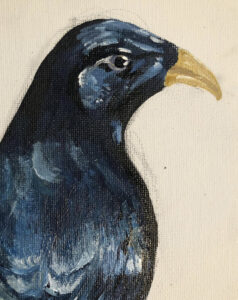 ‘Bowerbird Blue’ is an illustration responding to the colour blue as a metaphor for distance and longing, and homesickness.
‘Bowerbird Blue’ is an illustration responding to the colour blue as a metaphor for distance and longing, and homesickness.
Through re-reading Bluets, I reunited with the satin bowerbird, a bird I often encountered during my childhood in Australia. Native to Australia and Papua New Guinea, the bowerbird is a common yet enigmatic bird known for their attachment to all things blue.
Blue is their means of cultivating home, mating, and survival. As Nelson explains in Proposition 67:
Not only does the bowerbird collect and arrange blue objects–bus tickets, cicada wings, blue flowers, bottle caps, blue feathers plucked off smaller blue birds that he kills, if he must, to get their plumage–he also paints his bower with juices from blue fruits, using the frayed end of a twig as a paintbrush.13
The bowerbird paints his home with blue, claiming it as a site of distance and desire. He dwells in it, paces around it, and sings in it.
I found it difficult to write about the bowerbird, the airplane screens, or the stretches of sea between my homes. I had to dip brushes and twigs into paint and mark my own bower blue.
Although I identify primarily as a poet and writer, I chose to embrace colour and practice painting the bowerbird with acrylic paint on canvas, noticing the luminous blue of its wings, a blue he shares in common with the rainbow lorikeets, the Pacific Ocean, and the clouds of eucalyptus oil that settle across the Blue Mountains of New South Wales.
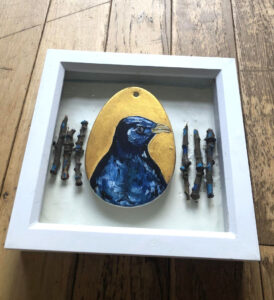 Because Solnit writes, ‘Blue is the color of where you are not’, I considered the vast distance between Scotland and Australia, gathering twigs from the Fife coast and painting them with hints of blue to suggest a bower. These twigs enshrine my hand-painted portrait of a bowerbird on ceramic. My painting style and use of gold paint was informed by an abiding love for medieval iconography and illustration, particularly the artist Jackie Morris’ paintings of British wildlife in Robert MacFarlane’s The Lost Words: A Spell Book (2017).14 This portrait of distance rests against the backdrop of an illuminated egg, a mandorla-like shape, echoing the final lines of Bluets: ‘When I was alive, I aimed to be a student not of longing, but of light.’15
Because Solnit writes, ‘Blue is the color of where you are not’, I considered the vast distance between Scotland and Australia, gathering twigs from the Fife coast and painting them with hints of blue to suggest a bower. These twigs enshrine my hand-painted portrait of a bowerbird on ceramic. My painting style and use of gold paint was informed by an abiding love for medieval iconography and illustration, particularly the artist Jackie Morris’ paintings of British wildlife in Robert MacFarlane’s The Lost Words: A Spell Book (2017).14 This portrait of distance rests against the backdrop of an illuminated egg, a mandorla-like shape, echoing the final lines of Bluets: ‘When I was alive, I aimed to be a student not of longing, but of light.’15
In Eastertide, this can also be a reminder that sometimes that distant, heavenly blue world comes towards us in brushstrokes and broken branches so that we may look upon it and build a home (or bower) with its light.

